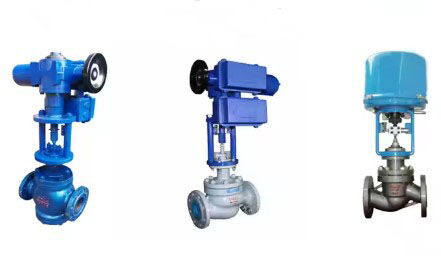Discrete & Analog Control Methods for Electric Control Valve
On this page
In industrial automation control systems, electric control valves play a crucial role in managing fluid flow. As automation technology has progressed, the methods for controlling electric control valves have become more diverse. Two of the most common control methods are discrete control (on/off) and analog control. Each method has its own operational principles, unique advantages, and best-use scenarios. Choosing the appropriate control method is essential for enhancing system efficiency, ensuring safety, and optimizing control accuracy.
Discrete control is a simple, two-state control method. It involves turning the electric control valve on or off based on a signal. This method is ideal for applications that don't require fine adjustments.
Discrete control is straightforward—it's all about switching the valve between two positions: "on" and "off". The valve receives a signal that tells it to fully open or fully close. These signals are typically passive, meaning they don't carry power but instead represent an "on" or "off" state using values like 0 or infinite resistance. Examples of discrete signals include relay contacts, valve cam switches, and auxiliary contacts from contactors.
Discrete control is widely used in situations where simple on/off control is sufficient. The electric control valve responds to these signals to fully control fluid flow.
Discrete control is suitable for applications where fine adjustments aren't necessary, such as water treatment, HVAC systems, and basic fluid control processes. Some common applications include:
Pipeline Isolation: When you need to quickly stop or isolate a pipeline, discrete control allows the valve to respond quickly, ensuring system safety.
Fluid Isolation: It helps ensure that different substances don't mix or unwanted fluids don't enter the system.
Emergency Shutoff: In case of system faults or abnormalities, discrete control can rapidly stop the flow, preventing further damage and ensuring safety.
Electric control valves with discrete control are easy to install, simple to operate, and cost-effective to maintain. They are well-suited for most basic industrial tasks. However, since they can only perform basic open/close actions, they're not ideal for applications requiring precise control over flow or pressure.
Analog control adjusts the electric control valve's position using a continuously varying signal. This allows for precise control of fluid flow, pressure, and temperature. Unlike discrete control, analog control uses signals with varying amplitudes, providing smoother and more accurate valve movements. It's ideal for situations where high-precision control is needed.
The main difference between analog and discrete control is that analog uses continuous signals. These signals (such as current or voltage) control the valve's opening, adjusting flow, pressure, and temperature. Common analog signals include 4-20mA current signals or 0-10V voltage signals. By adjusting the magnitude of these signals, you can precisely control the valve's position and fluid flow.
Electric control valves with analog control typically come with position feedback devices. These devices monitor the valve's actual position in real time, ensuring accurate and stable control.
Analog control is perfect for applications that need precise adjustments to fluid parameters, especially in dynamic environments where flow, pressure, or temperature must be continuously regulated. Some common applications include:
Chemical Production: In chemical processes, precise control of flow and pressure is critical, and analog control ensures smooth, stable operation.
Food and Pharmaceutical Industries: These industries often require precise temperature and flow control to maintain product quality and meet safety standards.
Water Treatment Systems: In complex water treatment processes, accurate control of flow and pressure improves efficiency and ensures water quality standards are met.
Analog control offers much higher precision and flexibility compared to discrete control. It's ideal for applications that need detailed adjustments to flow, pressure, or temperature. With real-time monitoring and adjustments, analog control ensures precise fluid flow control. However, analog control systems are more complex and expensive to install and maintain. They are best suited for industries that require high precision and can afford the additional costs.
Discrete control and analog control differ in their operating principles, applications, precision, and cost. Here's a quick comparison to highlight the key differences:
Discrete Control: Best for simple on/off control. It works well for opening or closing a valve completely, providing quick response and low cost. It's ideal for applications where precise flow or pressure control isn't needed.
Analog Control: Used for applications that require precise adjustment of flow, pressure, and other fluid parameters. Continuous signal adjustments allow for smooth valve operation, making it ideal for complex processes with dynamic control needs.
Discrete Control Applications: These include water treatment, HVAC systems, pipeline isolation, and emergency shutoff.
Analog Control Applications: Best for chemical production, food processing, pharmaceutical manufacturing, and water treatment systems—especially when high precision is needed for flow, pressure, or temperature.
Discrete Control: Offers great value, with low installation and maintenance costs. It's suitable for less demanding control tasks.
Analog Control: Provides higher precision and flexibility but comes with higher installation and maintenance costs. It's ideal for complex systems that require exact control.
Choosing the right electric control valve control method is critical to ensuring efficient and stable fluid control in industrial automation systems. Discrete control is great for simple on/off applications that need quick response and low cost. It's commonly used in water treatment, HVAC systems, and emergency shutoffs. Analog control, on the other hand, is perfect for complex processes that require precise regulation of fluid parameters, such as in chemical production, food processing, and pharmaceutical industries. By understanding the differences between these control methods, you can select the one that best fits your needs and ensure your automation system performs optimally.

